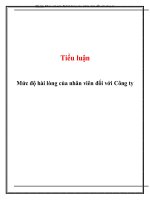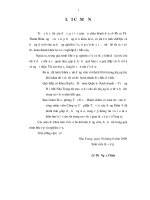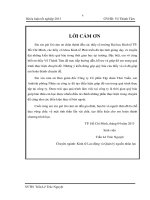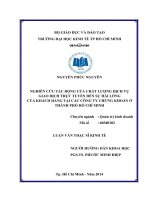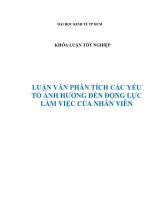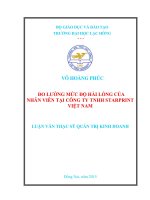Nghiên cứu về mức độ hài lòng của nhân viên tại các công ty dệt may ở Đà Nẵng (bản tiếng anh)
Bạn đang xem bản rút gọn của tài liệu. Xem và tải ngay bản đầy đủ của tài liệu tại đây (245.57 KB, 18 trang )
Science Research Report
Science research topic
Research about staff satisfaction in the
textile Enterprises in
Danang
Group Members:
•
•
•
Nguyễn Đông Hưng
Nguyễn Hữu Nhật Duy
Lê Đức Tin
1|Page
DaNang University of Economics
Science Research Report
Introduction
2.1
The Urgency of the Topic
Vietnam are actively involved in the agreements and the international trade communities as
TPP, EUFTA, AEC ... so that Vietnamese corporations are having great opportunities thanks to
this. However, there are some challenges that they have to face and the improvement of
competitive ability becomes ever more urgent.
Vietnam is surplus of labor but intermediate and advanced-level-workforce are extremely
scarce. The current competition is really fierce and there will be more foreign companies to jump
into the Vietnam market, so the risk of high-quality labor force transferred to work for them is
very high, which leads to brain drain phenomenon, the decrease of productivity and work
efficiency and losing home market is obviously happens. So Vietnamese corporations in general
and companies in labor-intensive sectors such as textiles in particular should consider the
laborforce as a key factor for their survival.
The creation of a stable and high quality workforce will help businesses save more costs, reduce
errors in the work and create the trust and solidarity work environment. To achieve this, the job
satisfaction of employees in the enterprise is very important. So our group decided to choose the
topic "Research about the staff satisfaction in the textile enterprises in Danang" to help
Vietnamese enterprises in the textile sector can better care their staff, improve their satisfaction
thereby improving labor productivity in order to compete with rivals in the region and the world.
Research Objectives
•
•
•
•
2.2
Identify the factors affecting the level of satisfaction of employees in the textile
enterprises
Identify the importance of each factor to the satisfaction of the employees at the
textile enterprises
Identify the general satisfaction level of employees as well as their level of
satisfaction to each factor affected.
Inspect the relationship between individual characteristics (gender, age) and
employee satisfaction
Research Questions
•
•
•
2|Page
What are the factors that affect the satisfaction of employees at the textile
enterprises?
How do these factors affect the satisfaction of employees at the textile
enterprises?
what is the level of general satisfaction of employees ?
DaNang University of Economics
Science Research Report
•
2.3
Are there any differences in the level of satisfaction of employees between age
and gender in the textile enterprises or not?
Subjects and scope of Research:
The employees are currently working in Danang Textiles corparation such as Hoa Tho, 29/3,
DANATEX, VINATEX.
2.4
Report Layout:
Beside the Introduction, this report includes 6 chapters :
Chapter 1. Theoretical bases for the employees’ job satisfaction in organizations
Chapter 2. Research Design
Chapter 3. The research results of the employee satisfaction of the textile
enterprises in Da Nang
Chapter 4. Conclusions, policy implications, limitations of research, and future
research directions
Chapter 5. References and appendices
Chapter 1.
THEORETICAL BASES FOR THE JOB SATISFACTION OF
EMPLOYEES FOR ORGANIZATIONS
3|Page
DaNang University of Economics
Science Research Report
1.1
EMPLOYEE SATISFACTION
1.1.1 The concept of employee satisfaction
Weiss’s concept of satisfaction (1967): Job satisfaction is attitude of working which is expressed
in feeling, beliefs and behaviors of worker.
Concept of satisfaction of Smith, Kendal & Huilin (1969), Schemerhon (1993), Kreitner &
Kinicki (2007) to several parts of job such as: type of job, development & training opportunity,
leadership, partner, salary, position, bonus & treatment.
In summary, the worker can get satisfaction whener they feel interesting, comfortable, & react
positive to some aspect of working.
1.1.2 The theory of job satisfaction
Job satisfaction research is often associated with encouragement & working satisfaction theory
by researchers. In addition to the theory, such as two-factor theory of Herzberg (1959), needs
theory of Abraham Maslow's hierarchy (1943), ERG theory of Clayton P.Alderfer (1969),
expectationst theory of Victor Vroom (1964 ), the theoretical of job characteristics model
(Hackman & Oldham, 1974) has developed in order to determine how to organize jobs for
motivation’s workers to work by themself as well as creating job satisfaction in general and the
best work efficiency.
1.2. Models of application of satisfaction research
1.2.1. The JDI index's job description of Smith, Kendall and Hulin (1969)
JDI Scale of job description (Job Descriptive Index) which is established in 1969 by Smith is one
of the most valuable and reliability scale in theory and practice. The scale including five factors:
(1) The nature of work, (2)Training and Promotion opportunities, (3) Leaderships, (4) Coworker,
(5) Salaries.
After that, Crossman and Bassem (2003) had added two more factors: welfare and working
environment.
1.2.2. MSQ Model (Minnesota Satisfaction Questionnaire)
Weiss, Dawis, England & Lofquist (1967) has developed MSQ model including 20 factors
assess the overall satisfaction of each five aspects: usability, achievements, activities,
opportunity, power, company policies, compensation, coworkers, creative, independent, safety,
social services, social status, moral values, recognition, responsibility, inspection - human ,
inspection - technical, diversity, working conditions.
4|Page
DaNang University of Economics
Science Research Report
Worrell (2004) have used modified versions MSQ 1977 (short questionnaire - 20 questions) to
conduct their research on psychologists staff’s job satisfaction in schools. Şerife Zihni Eyupoglu
and Tulen saner (2010) also used the MSQ model to research in North Cyprus.
1.2.3. JSS Model (Job Satisfaction Survey)
JSS model of Spector (1997) had developed to apply to service-businesses, including 9 level of
satisfaction and attitudes factors such as: salary, career development, working conditions,
inspection, partner, passion, information communication, unexpected rewards and welfare.
1.2.4. Research on personal factors affecting to the job satisfaction of
employees
•
Studies about affect of gender to the job satisfaction of employees
Some studies conducted have shown that the relationship between gender and job satisfaction
like research of Murray, Atkinson (1981), Tang and Talpade (1999), E.O Olorunsola (2010) ...
• Studies about affect of age to the job satisfaction of employees
According to Greenberg and Baron (1995), Drafke and Kössen (2002), they said that there is a
relationship between age and job satisfaction
Chapter 2
RESEARCH DESIGN
1.2
5|Page
Research process
DaNang University of Economics
Science Research Report
Research process is divided into the following steps: (1) develop theoretical models and state
hypothesis ; (2) design the questionnaire, adjust the scale, conduct sampling; (3) survey, data
collection; (4) data entry and data processing; (5) test the scales; (6) after testing the scales,
studying the satisfaction of the employees at the textile enterprises in Da Nang city
(7) conclusions, comments and recommendations.
1.1
Building a research model and develop theories
1.1.1 Building a research model
We used model JDI (Job Descriptive Index) and adjusted 7 factors, concluding 5 factors set up
by Smith et al in 1969 and the other two factor are complemented by Crossman and Bassem
(2003)
Work
Employee Satisfation
Salary
Training and
Promotion
Leadership
Coworker
Working
Environment
Demographic
-
Age
Gender
Welfare
1.1.2 . Developing hypothesis
•
Group 1 (answer research question "How do these factors affect the employee
satisfaction at the textile enterprises")
Hypothesis H1: There is a positive relationship between “ work ” and employee
satisfaction
6|Page
DaNang University of Economics
Science Research Report
Hypothesis H2: There is a positive relationship between “ Leader ” and
employee satisfaction
Hypothesis H3: There is a positive relationship between “Coworker” and
employee satisfaction
Hypothesis H4: There is a positive relationship between “ Welfare ” and
employee satisfaction
Hypothesis H5: There is a positive relationship between “Promotion
opportunities” and employee satisfaction
Hypothesis H6: There is a positive relationship between “Working Environment
” and employee satisfaction
•
Hypothesis H7: There are positive relationships between “pay” and employee
satisfaction
Group Hypothesis 2 ( answer research questions, "Are there any differences in the
level of satisfaction of employees between age and gender in the textile enterprises
or not?"
Hypothesis H8: There are differences in the level of employee satisfaction by
age
Hypothesis H9: There are differences in the level of employee satisfaction by
gender
Preliminary research
•
•
•
Qualitative research method is used in the preliminary research stage: study secondary
documents and discussions, outline the preliminary questionnaire.
Pre-test questionnaire: get feedback from instructors and start to survey with sample size
n = 20
From the comments, start adjusting the scale, the scale is adjusted as follows:
7|Page
Factor
Var
Indicator
Nature of work
CV1
The work express the social position
CV2
The work allows good personal capacity using
CV3
The work is suitable with capacity and technique
CV4
The work facilitates improving the skills and knowledge
DaNang University of Economics
Science Research Report
Leadership
Coworker
Welfare
Training and
Promotion
Working
Environment
Salary
Satisfaction
1.2
•
CV5
Work pressure is less
LD1
Leaders have polite and comely behavior
LD2
Leaders are capable and highly qualified
LD3
Employees are treated fairly, regardless
LD4
Leaders recognize the comments of staff
DN1
the friendliness of colleagues
DN2
The cooperation of the staff and colleagues at work
DN3
Support and mutual assistance of colleagues
PL1
Welfare policies are conducted clearly and fully
PL2
Welfare policy express thoughtful attention to workers
PL3
Welfare policies are attractive and useful
PL4
Rewarding policies are fair and appropriate
DT1
Staffs are trained for the job and career development
DT2
Staffs are supported time and cost for education of
improving capability
DT3
Good promotion opportunities
DT4
Fair promotion policies
DK1
reasonable working hours
DK2
Good working facilities
DK3
Safe, comfortable and hygienic working environment
TL1
Basic salary suits the nature of the job
TL2
You are assured with the current salary
TL3
Salary is commensurate with the level of contributions
TL4
Reasonable allowances
HL1
Your level of satisfaction on Jobs
HL2
Your level of satisfaction on Leadership
HL3
Your level of satisfaction on Coworker
HL4
Your level of satisfaction on Welfare
HL5
Your level of satisfaction on Training and Promotion
HL6
Your level of satisfaction on Working Environment
HL7
Your level of satisfaction on Salary
Formal research
Sample
8|Page
DaNang University of Economics
Science Research Report
The employees are currently working in Danang Textiles corparation such as Hoa Tho, 29/3,
DANATEX, VINATEX.
• Collect the data :
Data collection method is to delivery questionnaire at the time of conducting the survey,the
number of actual obtained questionnaire was 100
1.3
•
•
Methods of data analysis were applied:
Anova to test hypotheses H8 and H9.
Using CFA to confirm the factors in the questionnaire whether they are appropriate or
not and answering the research question "Are there any other factors affect the
satisfaction of employees in textile companies?" (Because questionnaire and research
model were taken from a similar research so that we don’t need to run EFA).
Using Linear regression to determine how these factors influence employee satisfaction
as well as to test hypotheses H1 to H7.
Using methods of description analysis to describe some data such as average satisfaction
or the median age ..
•
•
Chapter 3
THE RESEARCH RESULTS OF THE EMPLOYEE
SATISFACTION OF THE TEXTILE ENTERPRISES IN DA
NANG
3.1. The results of description analysis about demographic information:
• Gender:
Frequency
Male
Female
Total
9|Page
Percent
51
49
100
51%
49%
100%
DaNang University of Economics
Science Research Report
We found that the rate of male is not inferior the female rate, even exceeds the proportion of
women, which demonstrates that the textile sector is not just for women.
• Age
Frequency
< 25
25 - 40
> 40
Total
Percent
28
61
11
100
28%
61%
11%
100%
In terms of age, the amount of over 40-year-old people accounts for just 11%, which proves
that employees in Danang textile industry is really young, mostly aged from 25 to 40.
3.2. Analysis CFA to test the scales
Because the scale of the this research isi referenced from previous studies and it has been tested
according with the conditions in Vietnam, so we do not need to run the EFA but only use CFA.
The factor loading between the observed variables used to measure the concepts are standard > .
50 except CV5 , so we eliminate CV5, thus components of the “Nature of work” only remain 4
observed variables.
Model
Default model
Saturated model
Independence model
It could be said that this model is suitable for the market data because Chi-square = 1,959 (<3);
GFI = 0658; TLI = 0832; CFI = 0.851 (> 0.8); RMSEA = 0098 (<0:10).
<->
<-DN
>
<-PL
>
<-DT
>
<-DK
>
TL <-LD
10 | P a g e
CV
.737
CV
.578
CV
.463
CV
.668
CV
.632
CV
.727
LD
LD
LD
DN
DN
DN
DN
DN
PL
PL
<-->
<-->
<-->
<-->
<-->
<-->
<-->
<-->
<-->
<-->
DK
TL
HL
PL
DT
DK
TL
HL
DT
DK
.506
.661
.736
.573
.535
.576
.543
.650
.783
.537
PL
PL
DT
DT
DT
D
K
D
K
TL
e5
<-->
<-->
<-->
<-->
<-->
TL
HL
DK
TL
HL
.819
.782
.577
.913
.878
<--> TL
.656
<--> HL
.714
<--> HL
<--> e9
.939
.603
DaNang University of Economics
Science Research Report
>
<-HL
CV
.797
>
<-LD
DN
.686
>
<-LD
PL
.533
>
<-LD
DT
.613
>
Correlation :(Group number 1- Default model)
e2
<--> e33
4
.573
The correlation coefficients between concepts and accompanying standard deviation show that
their values are less than 1 (statistical significace).
3.3. The analytical results of quantitative variables:
•
Nature of work
Mean
3.35
3.56
3.42
3.52
2.82
CV1
CV2
CV3
CV4
CV5
•
Mean CV = 3.34
Leadership
Mean
3.44
3.46
3.41
3.41
LD1
LD2
LD3
LD4
•
Mean
3.64
3.64
3.66
Std. Deviation
1.106
1.106
1.027
Mean DN = 3.65
Welfare
Mean
3.27
3.15
3.17
3.25
PL1
PL2
PL3
PL4
•
Std. Deviation
1.104
1.158
1.232
1.280
Mean LD = 3.43
Coworker
DN1
DN2
DN3
•
Std. Deviation
1.158
1.241
1.296
1.210
1.329
Std. Deviation
1.221
1.229
1.190
1.292
Mean PL = 3.22
Training and Promotion
DT1
DT2
11 | P a g e
Mean
3.03
2.84
Std. Deviation
1.317
1.329
DaNang University of Economics
Science Research Report
DT3
DT4
•
2.94
2.85
Mean DT = 2.92
Working Environment
Mean
3.46
3.63
3.65
DK1
DK2
DK3
•
1.355
1.356
Std. Deviation
1.105
1.070
1.165
Mean DK = 3.58
Salary
Mean
TL1
TL2
TL3
TL4
•
Std. Deviation
3.09
2.69
2.81
2.85
1.296
1.253
1.290
1.290
Mean TL = 2.86
Satisfaction
Mean
3.20
3.21
3.66
3.12
2.83
3.55
3.01
HL1
HL2
HL3
HL4
HL5
HL6
HL7
Std. Deviation
1.025
1.085
.977
1.249
1.293
1.095
1.202
Mean HL = 3.22
3.4. Regression analysis result:
Results of regression analysis are presented in the following table:
Model Summary
Model
R
R Square
.897a
1
Adjusted R Square
.804
.789
Std. Error of the
Estimate
.3942
a. Predictors: (Constant), TL, DN, CV, DK, LD, PL, DT
12 | P a g e
DaNang University of Economics
Science Research Report
Results of linear regression with coefficient R2 is 0.804 the coefficient of adjustment R2 is
0.789. This implies that the appropriate level of the mode is 70.1% . In other words, 78.9% of the
variation of the employee satisfaction is generally explained by the variables in the model, we
can see, the relevance of the mode is relatively good. However this is only true with sample data.
To test whether the model can be deduced for the overall or not we have to test the suitability of
the model.
Model
7
Mean Square
8.378
Residual
14.299
92
.155
Total
72.943
99
Regression
1
Sum of Squares
58.644
ANOVAa
df
F
53.903
Sig.
.000b
a. Dependent Variable: HL
b. Predictors: (Constant), TL, DN, CV, DK, LD, PL, DT
In the analysis of variance ANOVA, F=53.903, are calculated from the value of R2 (sig =
0.000) , it indicates the appropriateness of the linear regression model with the data set analysis.
Coefficientsa
Unstandardized Coefficients
Model
B
(Constant)
CV
LD
DN
1
PL
DT
DK
TL
a. Dependent Variable: HL
Std. Error
.269
.190
.208
.110
.088
.110
.053
.122
.217
.066
.057
.061
.059
.066
.057
.076
Standardized
Coefficients
Beta
.219
.137
.101
.147
.076
.137
.286
t
Sig.
1.416
.160
3.122
1.933
1.433
1.879
.806
2.119
2.852
.002
.056
.155
.063
.422
.037
.005
Analysis Result of regression coefficient shows that the value Sig. of variables of CV- Nature of
work, DK- Working conditions and TL- Salary are smaller than 00:05, so we can say that these
3 factors are significant in the model and can affect staff satisfaction.
Thus, equation express the relationship between these factors and the satisfaction of employees
in the textile industry Danang as follows:
Satisfaction of employees = 0.208*CV+0.122*DK+0.217*TL +e
3.5. Hypothesis Testing:
•
Group 1 (answer research question "How do these factors affect the employee
satisfaction at the textile enterprises"):
13 | P a g e
DaNang University of Economics
Science Research Report
From the results of the linear regression we see only 3 factors is the Nature of work, Working
conditions and Salary that have statistically significant influence to the satisfaction of our
employees and all those 3 factors have positive beta index. Thus the hypothesis H1, H6 and H7
are accepted, the rest are rejected.
•
Group Hypothesis 2 ( answer research questions, "Are there any differences in the
level of satisfaction of employees between age and gender in the textile enterprises
or not?"
To determine whether there is a difference in the satisfaction of employees according to the
individual characteristics, we conducted testing average 2 samples parameters
On this basis, the author turns to conduct the following assumptions:
Hypothesis H8:
•
•
H0: There is no difference in the level of employee satisfaction by age
H1: There are differences in the level of employee satisfaction by age
ANOVA
Age
Between Groups
Within Groups
Total
Sum of Squares
9.760
26.350
df
24
75
36.110
Mean Square
.407
.351
F
1.157
Sig.
.308
99
ANOVA analysis results in the table show that the observed level of significance sig. = 0.308>
0.05,we do not have the basis to reject H0 ,so we are able to conclude that there is no
difference in the level of employee satisfaction by age.
Hypothesis H9:
•
•
H0: There is no difference in the level of employee satisfaction by gender
H1: There are differences in the level of employee satisfaction by gender
ANOVA
Gender
Between Groups
Within Groups
Total
Sum of Squares
7.273
17.717
24.990
df
24
75
Mean Square
.303
.236
F
1.283
Sig.
.206
99
ANOVA analysis results in the table show that the observed level of significance sig. = 0.206>
0.05,we do not have the basis to reject H0 ,so we are able to conclude that there is no
difference in the level of employee satisfaction by gender.
14 | P a g e
DaNang University of Economics
Science Research Report
Chapter 4
CONCLUSIONS, POLICY IMPLICATIONS, LIMITATIONS OF
THE STUDY AND FUTURE RESEARCH ORIENTATION
4.1. Conclusions
4.1.1. Result of research::
The results of regression model showed that “Salary” is the most influence on model (0217),
No. 2 which is also important factor is “the nature of work” (0208) and the last factors is
working conditions (0122)
Descriptive statistics analysis showed that:feeling of staff about satisfaction factors is in
medium-good level such as the nature of work (3:34), Leadership (3:43) , partner (3.65), welfare
(3:22), working conditions (3:58), but there are still elements to be underestimated as training
and advancement (2.92) and salary (2.86)
4.1.2. The achieved objectives of the study:
15 | P a g e
DaNang University of Economics
Science Research Report
Evaluated the satisfaction level of employees in the textile industry in Da Nang City .
Identified 3 factors affecting to employee satisfaction and arranged in descending order of
importance is salary, nature of work and working conditions.
By the hypotheses testing, the conclusion is that there is no difference in age and gender factor
about the satisfaction level of employees
4.2. Policy implications
4.2.1. Salary issues:
Although, the salary is the most important factor affecting to the level of employee satisfaction,
this factor be lowest evaluated, so that textile companies need to focus on the appropriate salary
structure for employees to be able to improve their satisfaction and productivity.
4.2.1. The issue of training opportunity (career development)
Training is key element to improve the quality of labor as well as opportunities for advancement
motivational work of the staff, however, the most underrated factors. So that companies should
improve their education, training & workshop should be held regularly, organizing overtime
courses for each division, team for training.
And the companies should have policies prove to all employees that the most ability and effect
one on working will get career development. Whenever there is vacancy or new positions,
company need to consider to priorities these one rather than hiring from outside the company.
4.2.2. Other recommendations
The company should keeping to develop organization culture and promote the traditional
relationship between colleagues together through meetings such as meetings, parties, travel ... to
link the relationship.
To improve employee satisfaction, companies need to reasonable assigned to strength of
employees; to support them to understand their the work; to make them see the importance of
their work as well as allow them to make decision on their capacity.
4.3. Limitations of the study and future research orientation.
4.3.1. Limitations of the study
•
•
•
The study's sample size was limited (100) due to limited resource and time.
Sample surveys are limited by the subjects of study, because it’s hard to access managers
so almost the respondents are worker in factories.
In the context of the strong opening of the country and needs of competitiveness
improvement but there aren’t comparison between satisfaction levels of employees in
domestic company and foreign company
4.3.2. Future research orientation
16 | P a g e
DaNang University of Economics
Science Research Report
In the future, we should expand the scale of research and make comparison of the difference in
the employees satisfaction at companies inside & outside the country to find out the advantages
and disadvantages, so that we can see solutions for improve much better competitiveness
Chapter 5
CATEGORY REFEREANCE
1/ Nguyễn Thị Thúy Quỳnh, Nghiên cứu sự hài lòng của nhân viên tại EXIMBANK chi nhánh
Đà Nẵng, Luận văn thạc sỹ, 2012.
2/ Hoàng Lệ Thương, Nghiên cứu sự hài lòng của người lao động trong công việc tại công ty cổ
phần dưọc phẩm BIBIPHAR 1, Luận văn thạc sỹ, 2013.
3/ Nguyễn Thanh Hoài, Nghiên cứu sự hài lòng của nhân viên đối với công việc tại trường cao
đẳng công nghệ thông tin hữu nghị Việt – Hàn, Luận văn thạc sỹ , 2013.
4/ Nguyễn Thị Hồng Mỵ, Nghiên cứu sự thỏa mãn của nhân viên khối văn phòng tại cục thuế
Quảng nam, Luận văn thạc sỹ, 2012.
17 | P a g e
DaNang University of Economics
Science Research Report
5/Th.S Hoàng Trọng, Th.S Chu Nguyễn Mộng Ngọc, Phân tích dữ liệu nghiên cứu với SPSS,
NXB Hồng Đức, TPHCM, 2008.
6/ Phân tích CFA-Cách chạy CFA bằng AMOS ( nhóm MBA thực hiện)
/>
18 | P a g e
DaNang University of Economics



